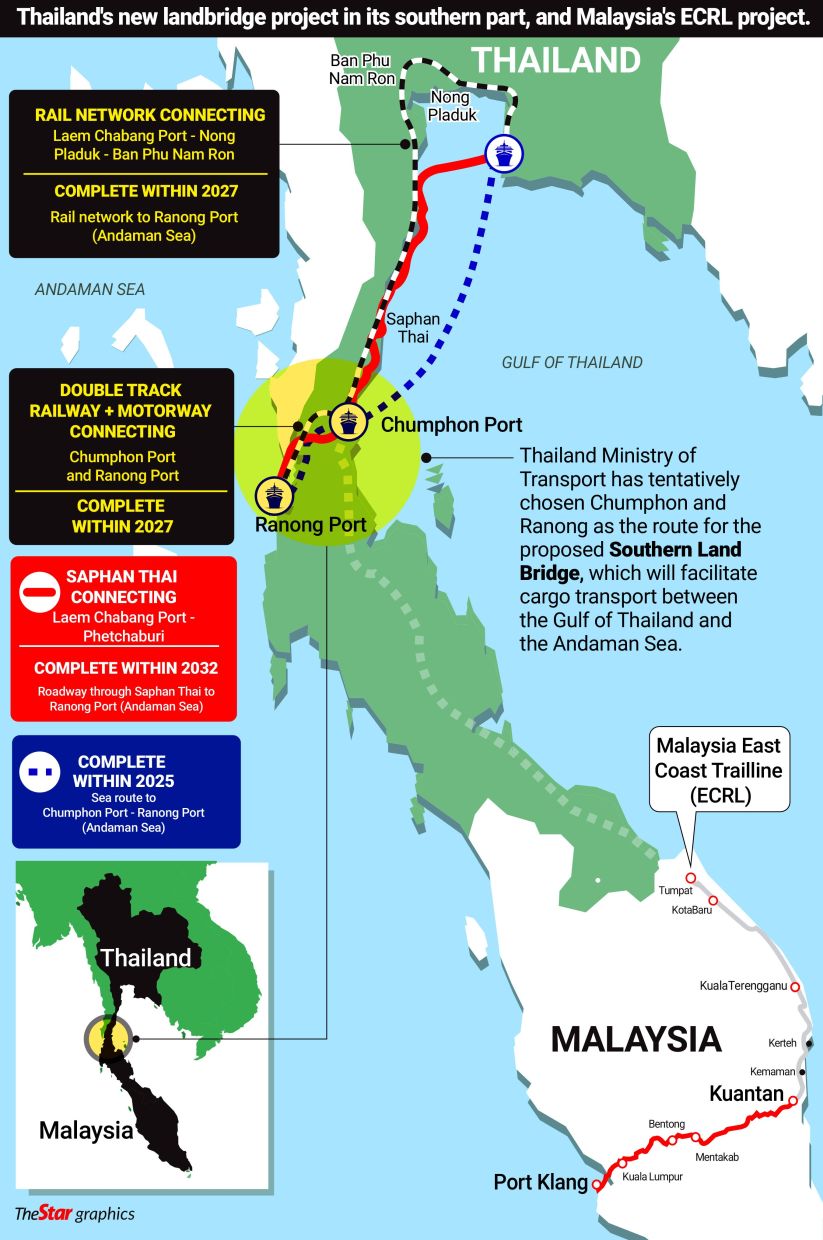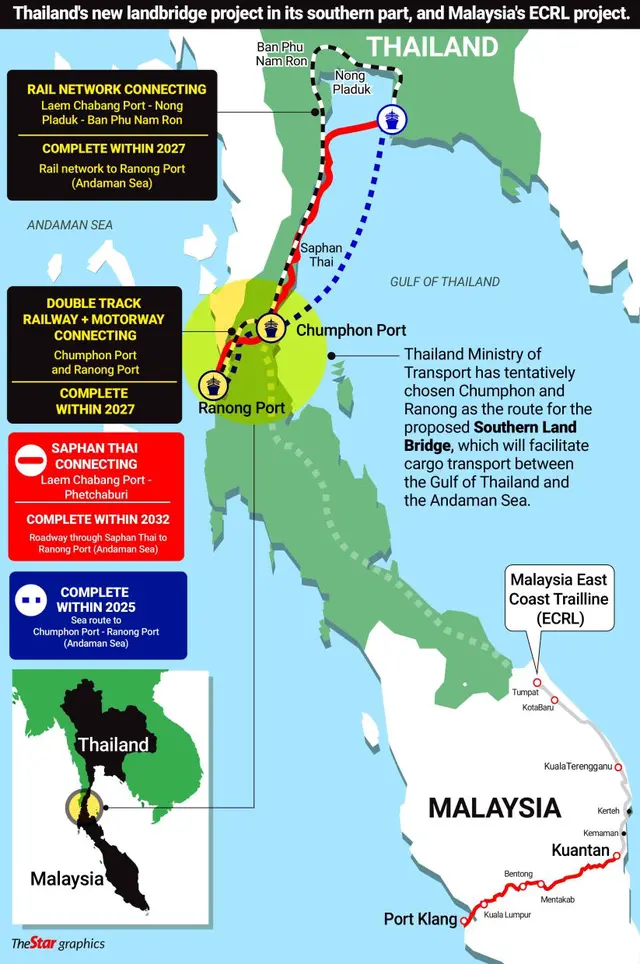MALAYSIA needs to cast its worrying politics aside and speed up the development of the East Coast Rail Link (ECRL), if it does not want this RM50bil landbridge project to be made irrelevant by a similar Thai southern plan.
The multibillion dollar landbridge plan, touted as a game changer for Thailand and slated to complete by 2027, will carry major economic and geopolitical implications for Malaysia and Asia.
From news flow, the Thai government is pushing ahead with the undertaking to build motorways and rail lines linking a new deep seaport on the Gulf of Thailand and another port on the Andaman Sea.
More details on this Thai project are expected this month, according to media reports quoting Thai Transport Minister Saksayam Chidchob.
The Bangkok Post reported last month that Saksayam had urged various agencies to expedite work on this southern mega project after attending a video conference on its progress.
In its May 6 report, the Post cited Saksayam as saying 16-metre-deep ports would be constructed at both ends of the landbridge, with direct links to the nation’s rail and highway networks.
The ports will accommodate goods and passenger transport, with the potential for oil pipeline transport, he said.

“The shortest and most direct routes between the ports will be chosen for the land bridge project, ” the minister said, adding locations in Chumphon and Ranong were being surveyed and special economic zones would be developed.
According to a Chinese YouTube post, China’s major state-owned infrastructure companies have informed the Thai government of their interest to participate in this project.
Bangkok had originally planned for a Kra Canal that would cost over US$28bil, jointly with Chinese state corporations. But this plan was cancelled last September due to high cost, high risk and challenges posed by difference in water levels.
The proposed gateway aims to make Thailand the main route for regional cargo and oil transporting from the Indian Ocean and the Persian Gulf to the Pacific, according to Thai media reports.
Although details on the so-called Chumphon-Ranong landbridge are scant, the project could come under Beijing’s Belt and Road Initiative to kick-start Thailand’s recovery from Covid-19.
If an oil pipeline is built, this could mean crude oil from the Middle East would be shipped to Ranong, and via the pipeline to Chumphon for tankers heading to China, Japan, and South Korea.
It makes business sense for an oil pipeline to be built as over 80% of the crude oil passing through the Straits of Malacca is bound mainly for China, South Korea and Japan.
As 80% of China’s oil imports worth about US$1.8 trillion pass through the South China Sea via the Straits of Malacca, it is logical Beijing wants a stake in this project to reduce reliance on the Straits amid rising tension with Washington.Like the ECRL, this Thai project – if implemented and completed by 2027 – will provide a shortcut and cheaper alternative route for shipping through the Straits of Malacca to the South China Sea, which sees cargo traffic of over US$5.3 trillion annually.
Without a doubt, this Thai plan will pose future competition to the ECRL, the Port of Singapore and Indonesia’s Sunda Strait and Lombok Strait.
The ECRL, targeted for completion in 2026, aims to capture similar cargo business via Kuantan Port in the east and Port Klang in the west.
As shipping times can be saved, it may be more time- and cost-efficient for west-bound cargo to use the Thai route, rather than venture further south.
Although Kuantan Port Consortium – owned jointly by JM Corporation Bhd and China-linked Beibu Gulf Holdings (Hong Kong) Company Ltd – may be able to bring in more Chinese cargo when the ECRL is completed, basic business principles will rule if the shorter Thai route is cheaper.
As the Thai project’s completion year is set for 2027 – one year later than ECRL’s, the ECRL must be completed long before the Thai project.
The ECRL should also start thinking of building niches before the Thai project becomes a reality.
However, there is a more urgent task now. The Federal Government must persuade the Selangor state government to put a stop to its refusal in granting approval for the “last mile” of the ECRL project in the state.
According to a Bernama report on March 31, the Selangor government was maintaining its stance in choosing the southern alignment for the ECRL, while rejecting the northern alignment.
As reports by both government and independent specialists have shown that the northern alignment will be able to spur more economic activities and capture more passengers both ways, it is sensible and logical to adopt the northern alignment.
Under the original plan by the Barisan Nasional government, the targeted completion for ECRL was 2024. But after Pakatan Harapan took over power in May 2018, the target was delayed to 2026 when they altered the alignment of the “last mile”.
And under the present government, the project was modified and the alignment reverted to the north as it is calculated to be economically viable. While there is no denial that all regimes seem to have political agendas, the yardstick to use should be economic viability and sustainability.
According to transport consultant Goh Bok Yen, who I interviewed last year, the northern route could lure more passengers – notably from the heavily populated Klang Valley, and generate much more income from commercial activities.
The politically-independent specialist warned last year: “The ECRL can become a white elephant if the last and most profitable section is chosen wrongly. The key return will come from this last mile and it is expected to subsidise other sections.”
With this external threat looming, our politicians should not waste time on trivial debates anymore. We have lost two years already.
If we want the ECRL to be successful and profitable, the project should not suffer any more delay. If we want it to be relevant, it must be completed far ahead of the Thai project.
(THE STAR)
 简体中文
简体中文

